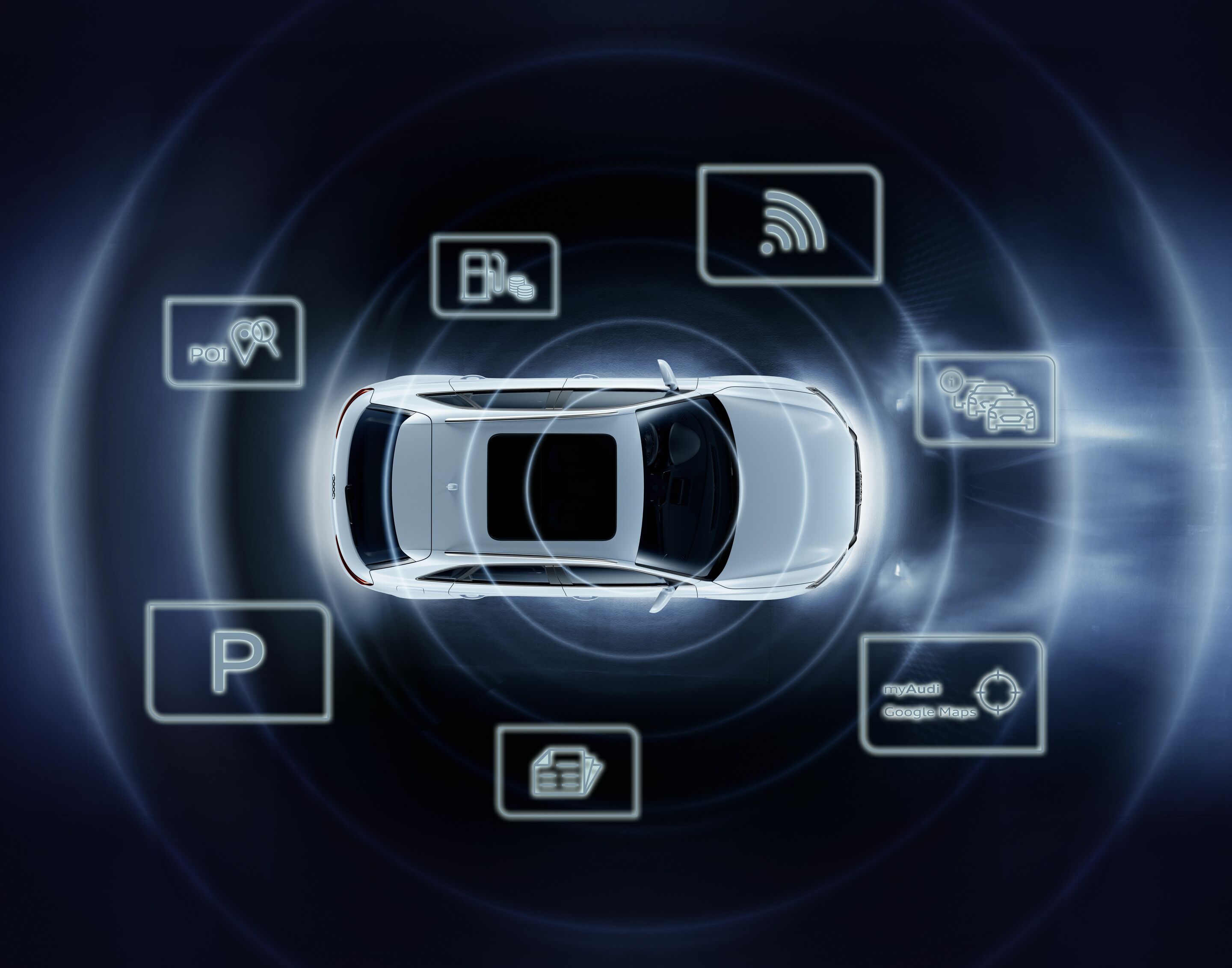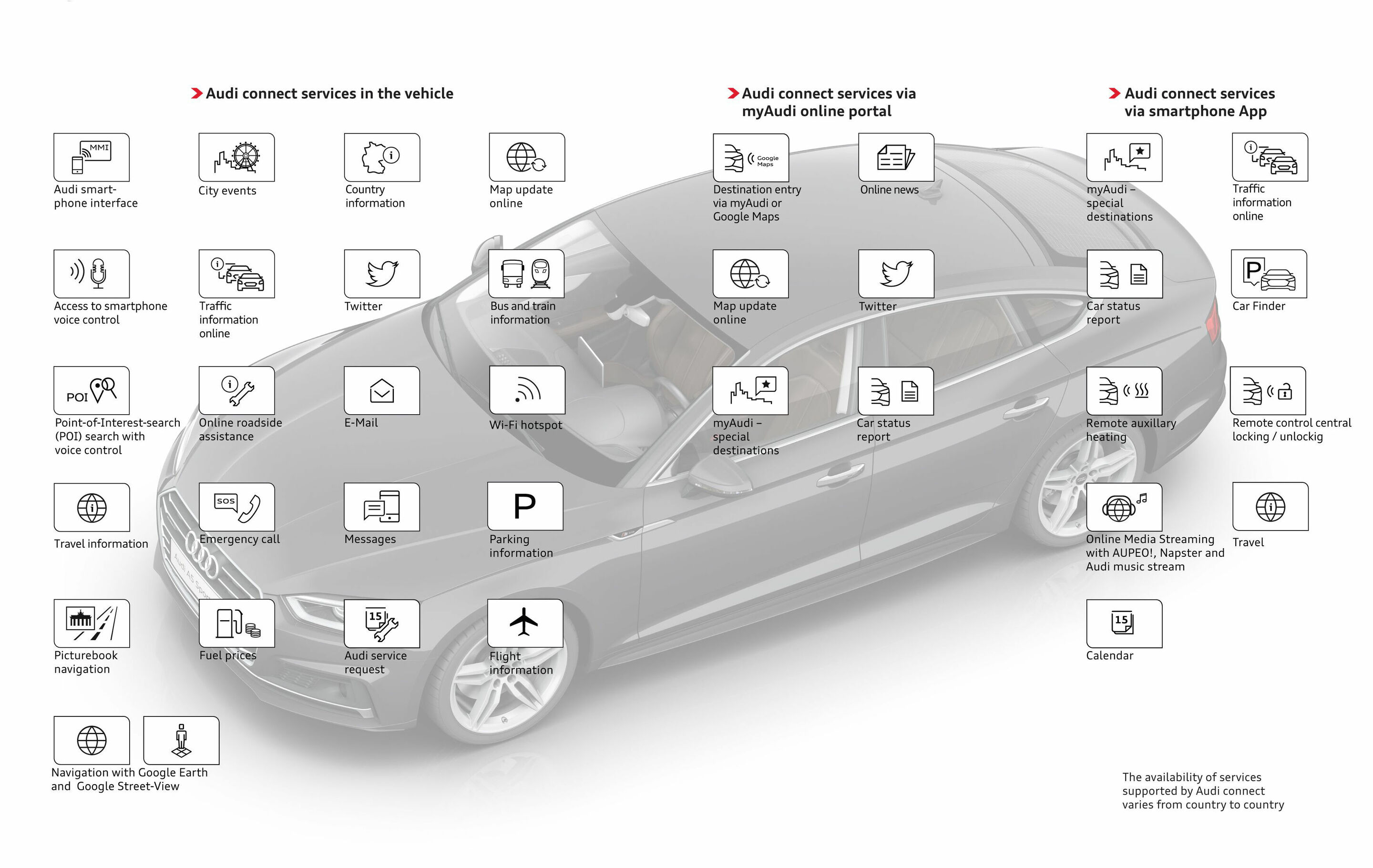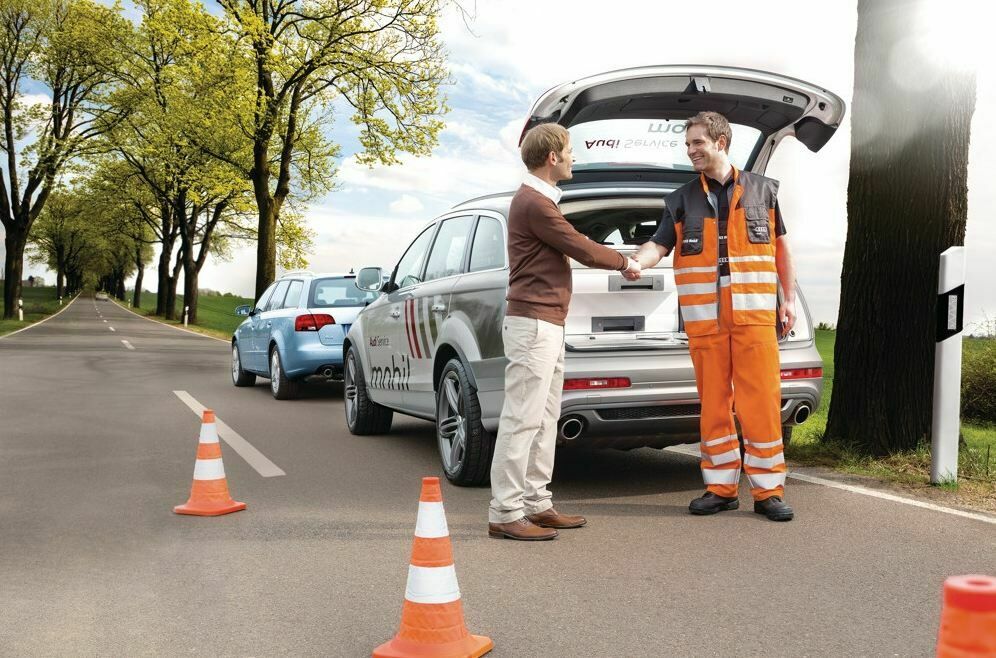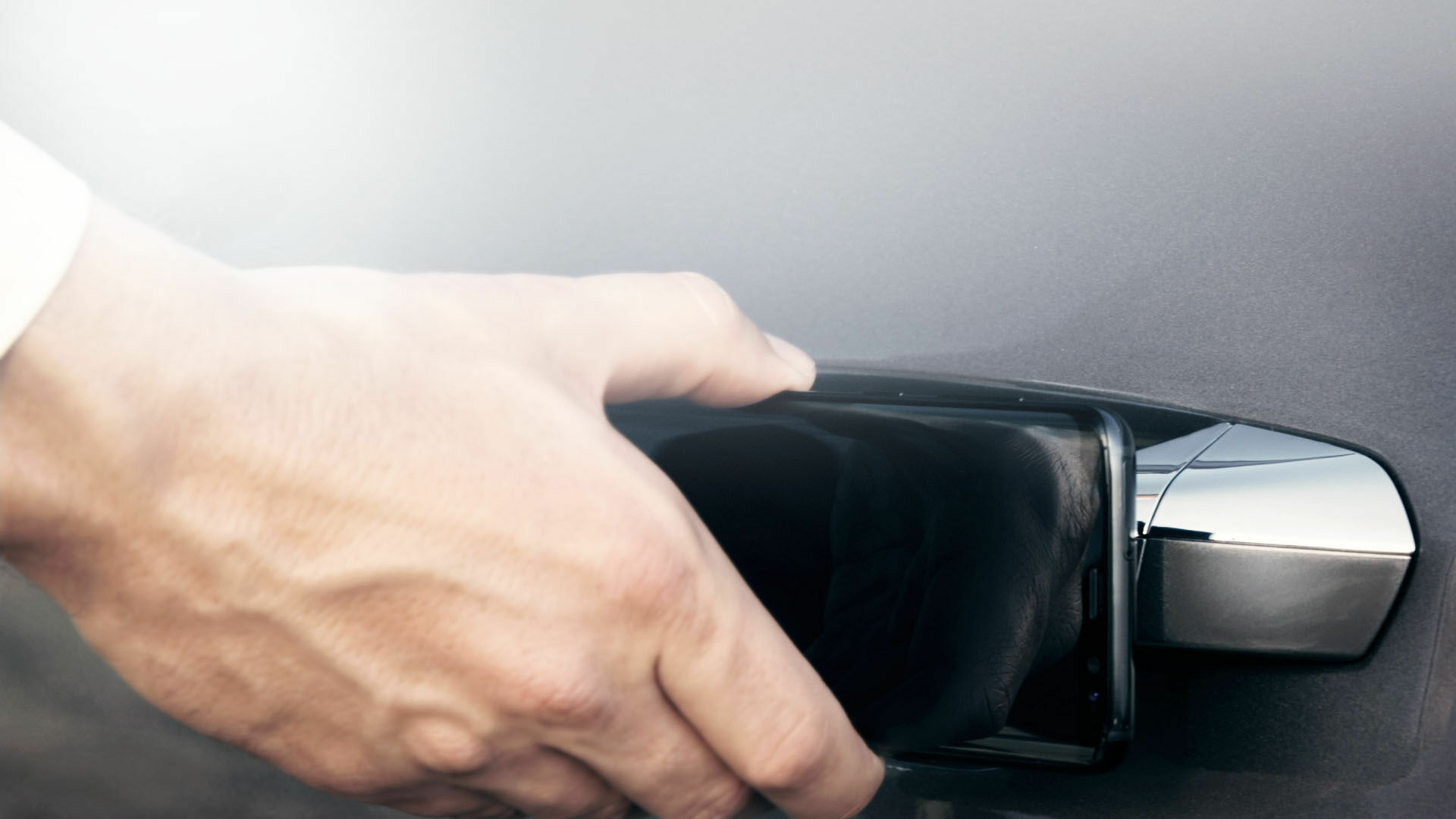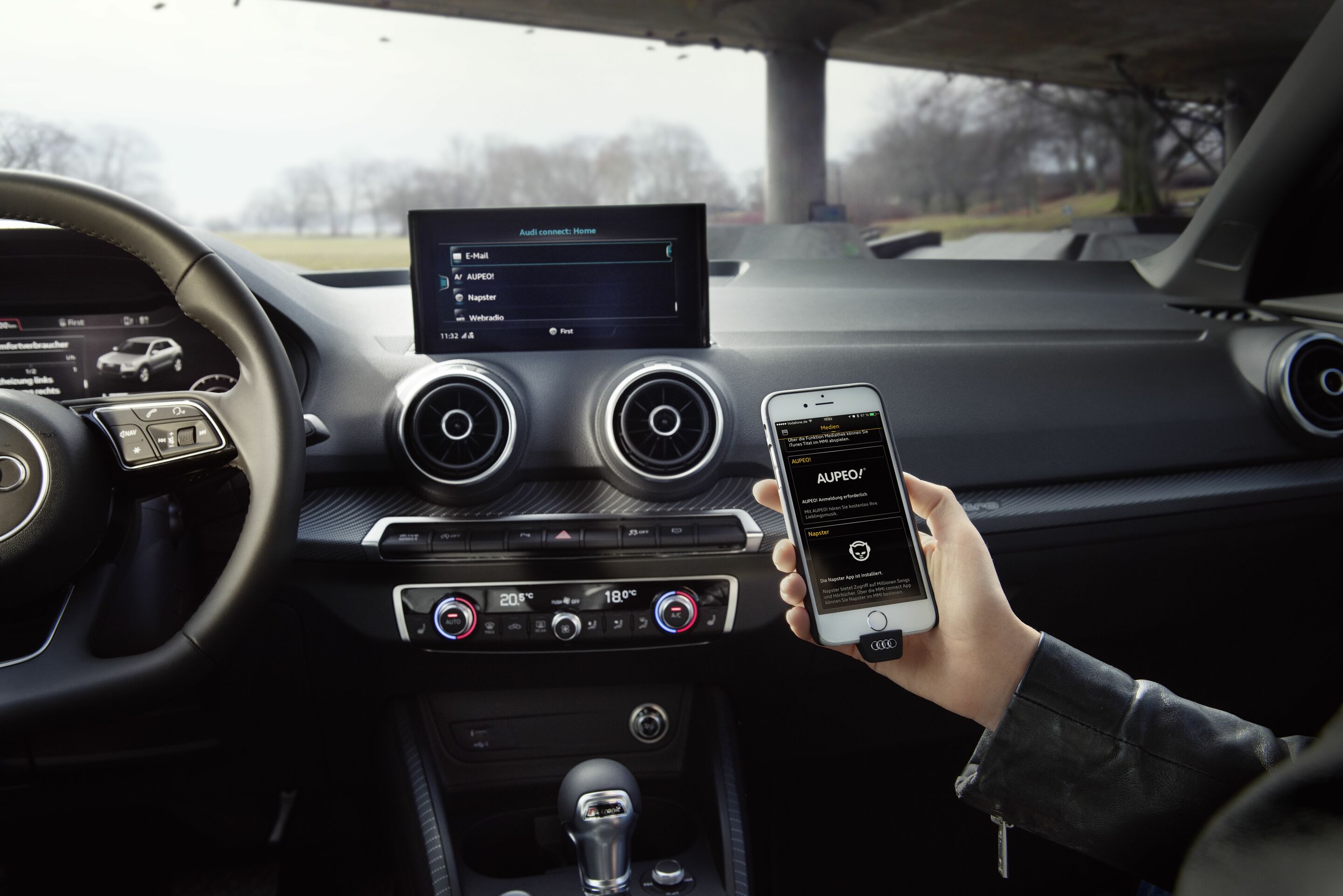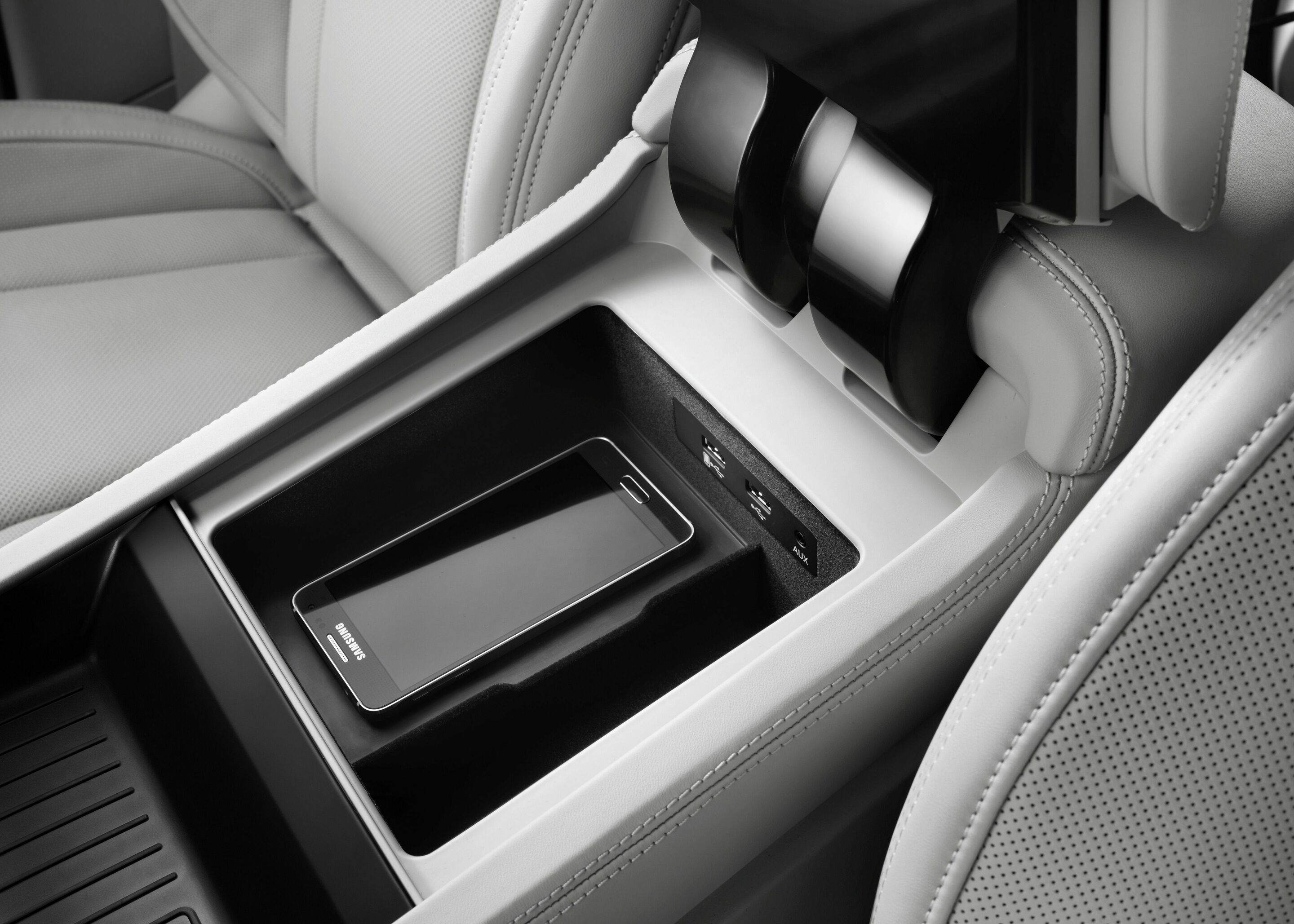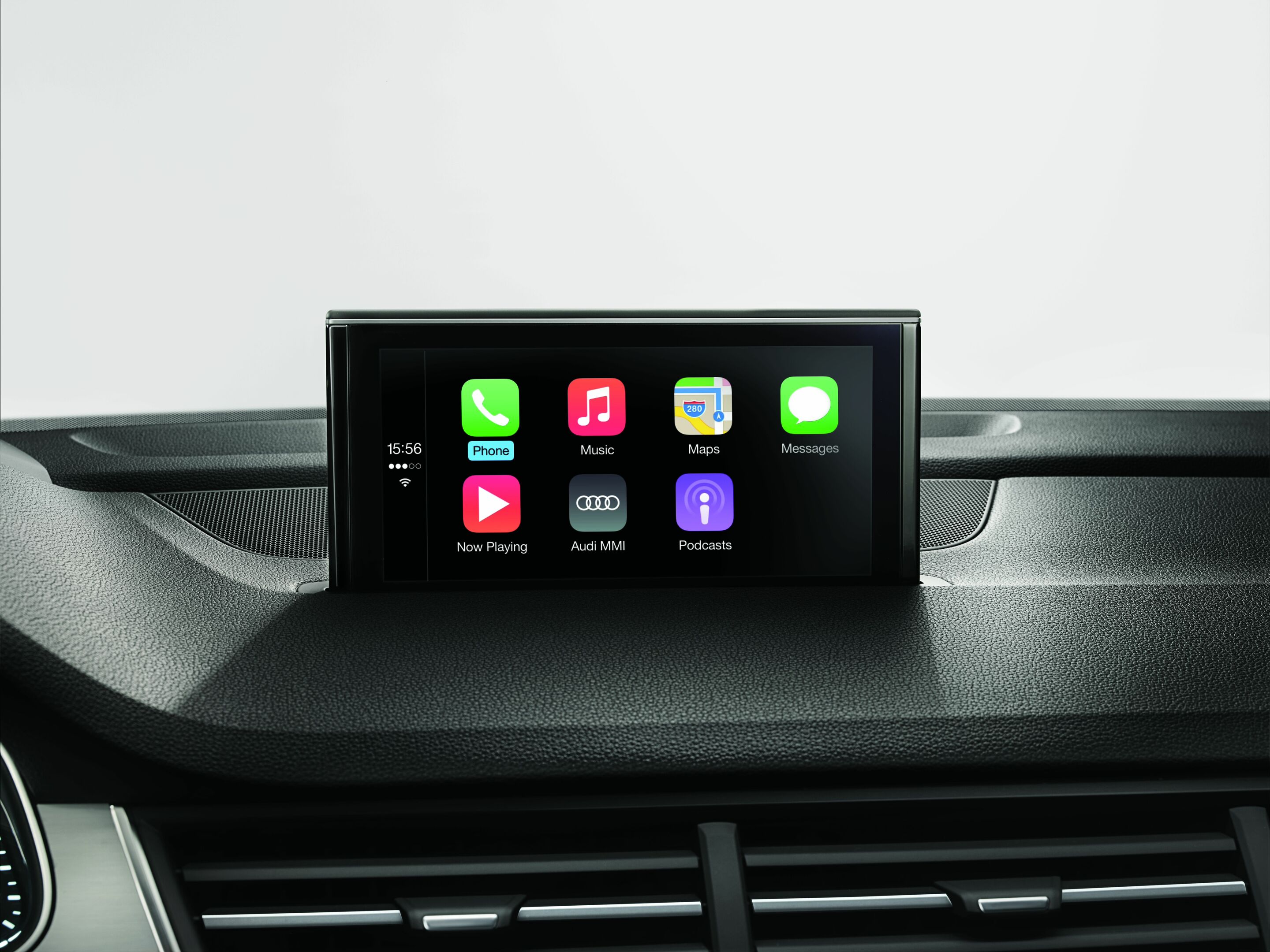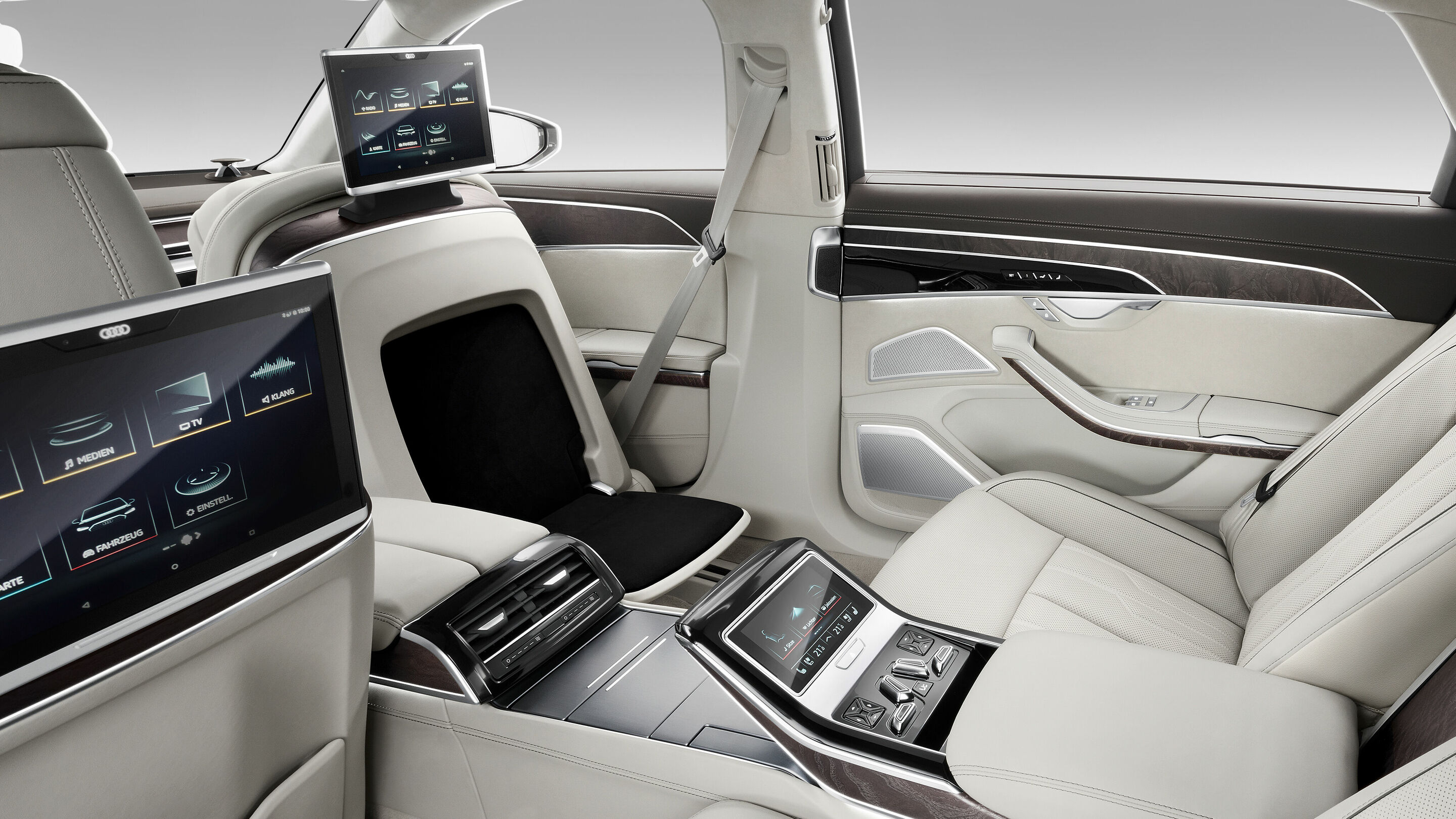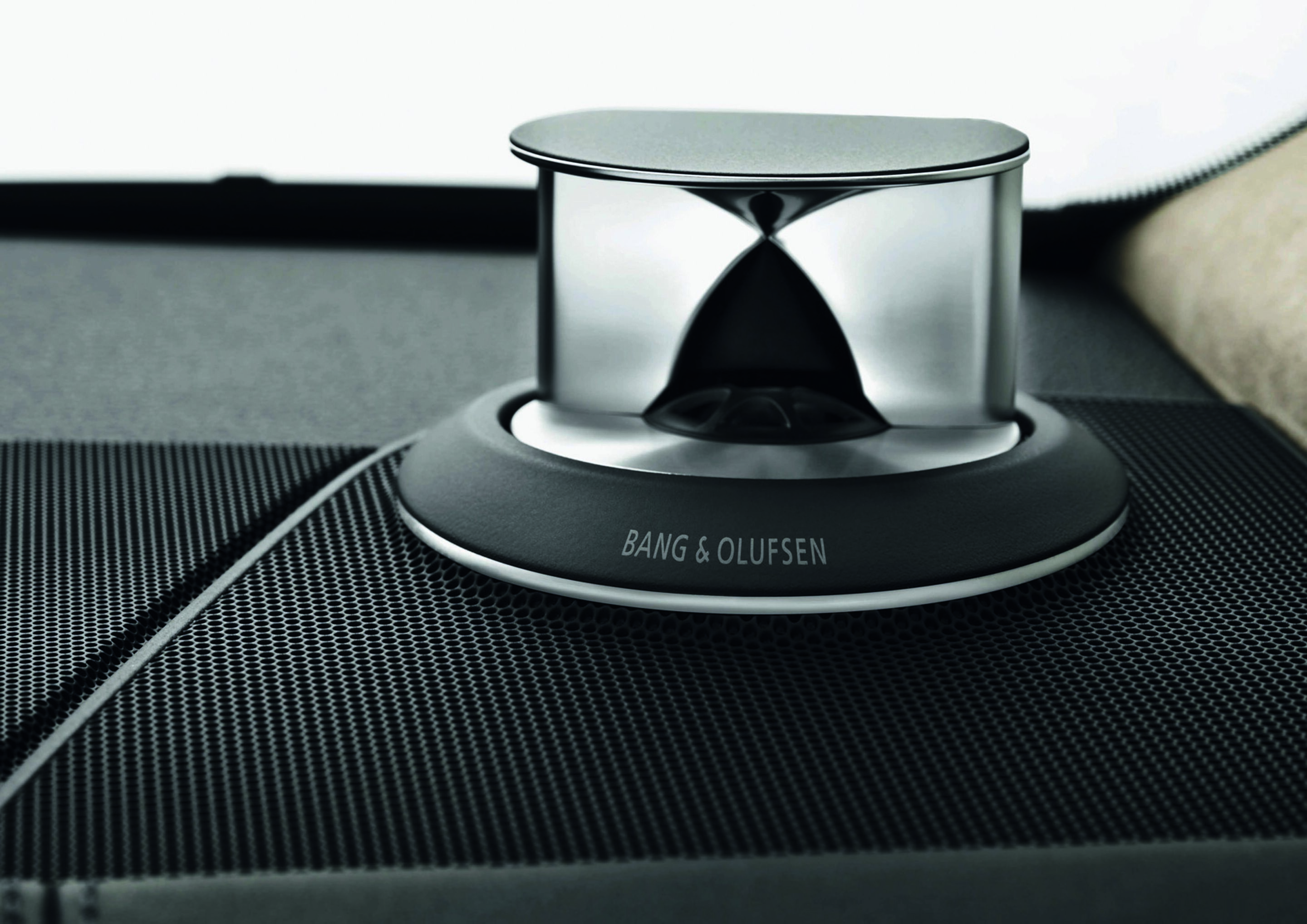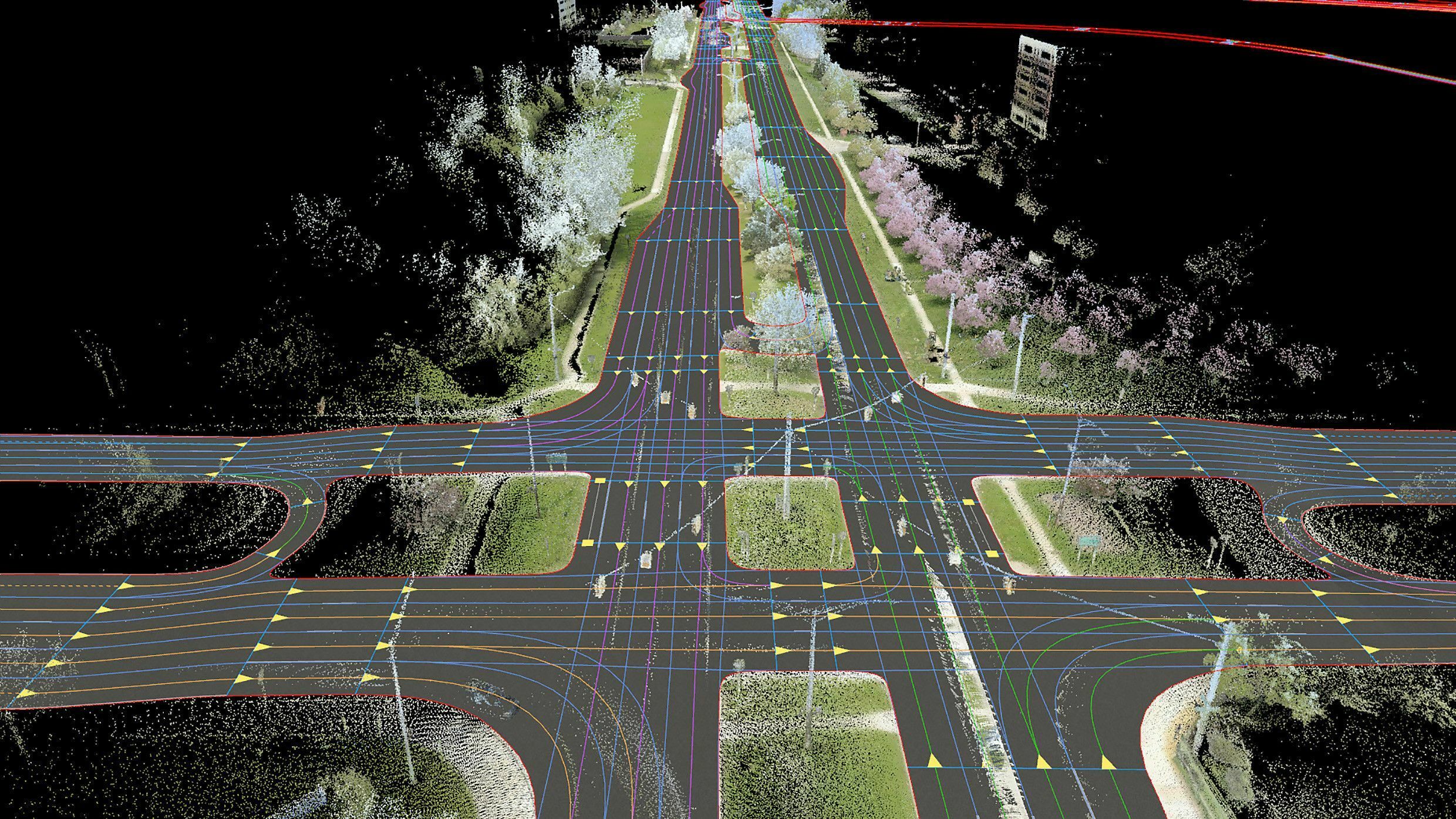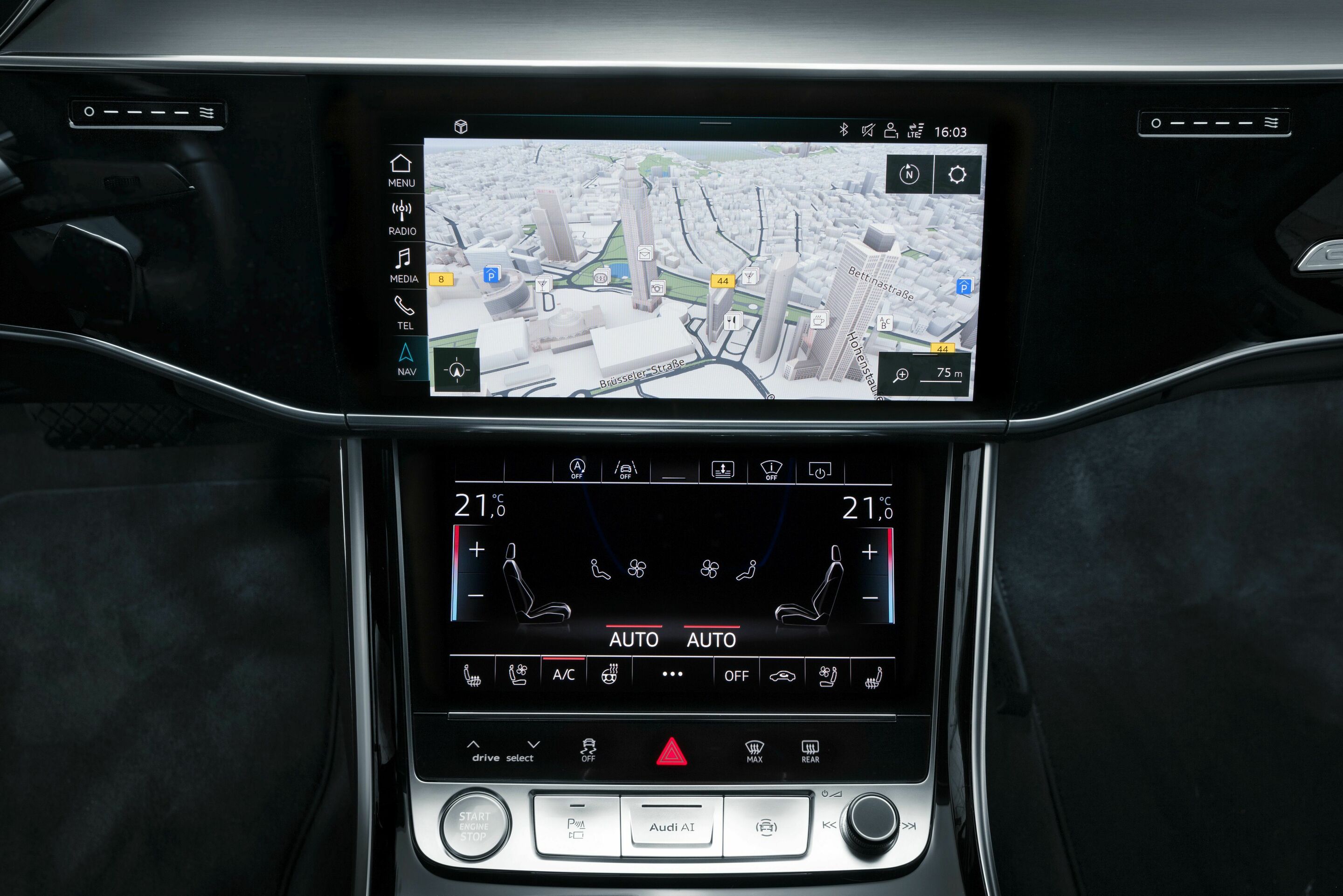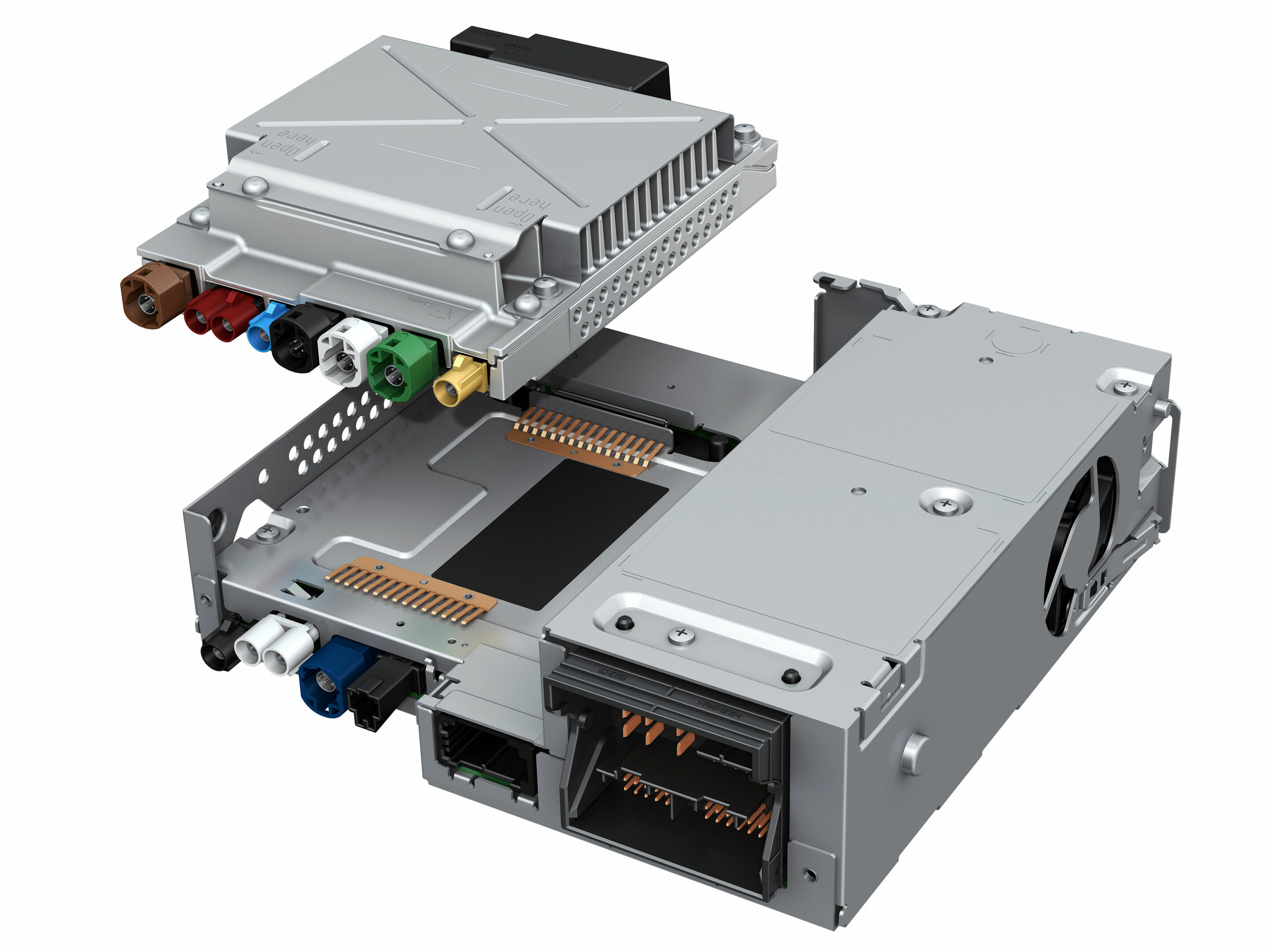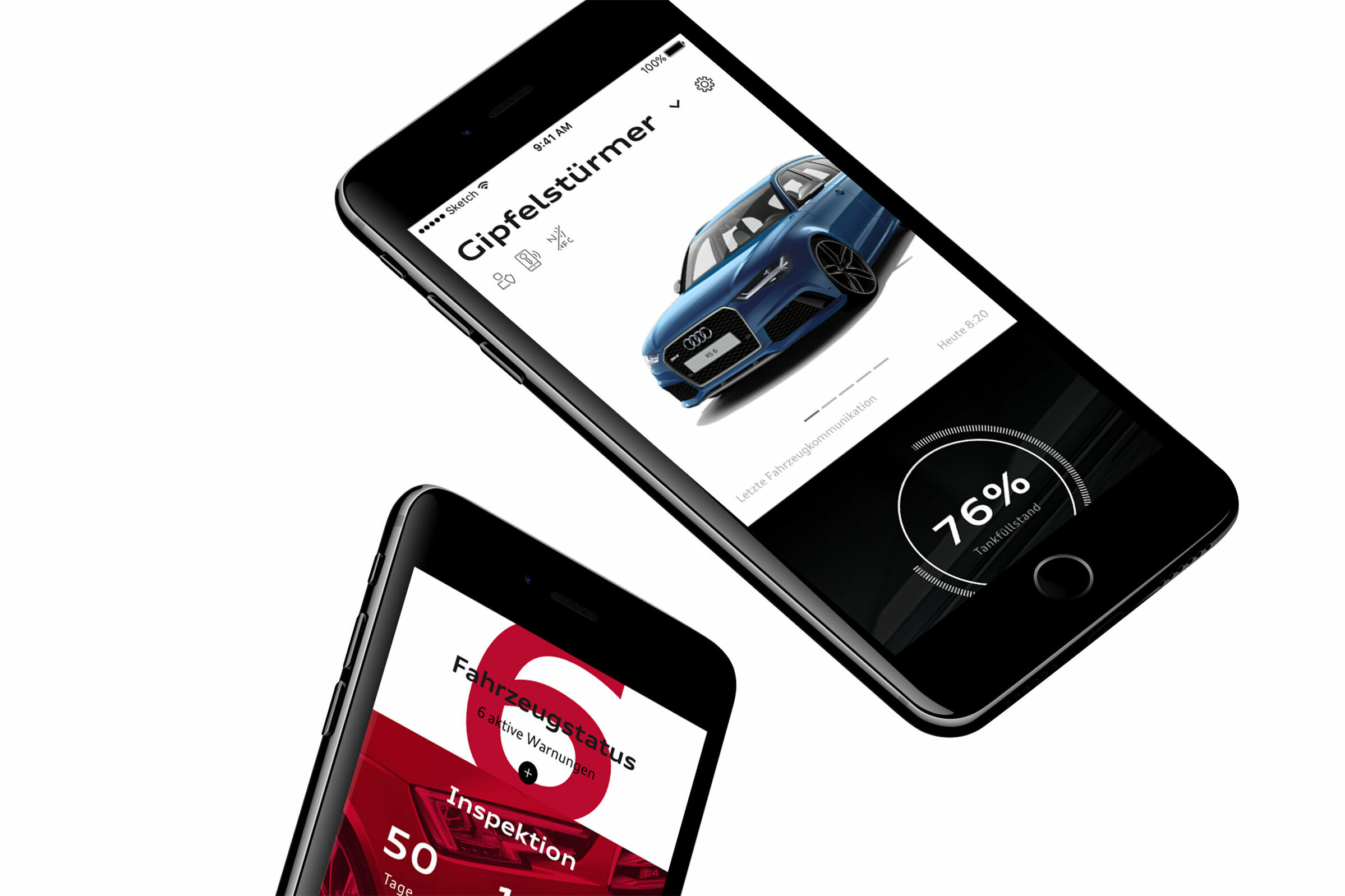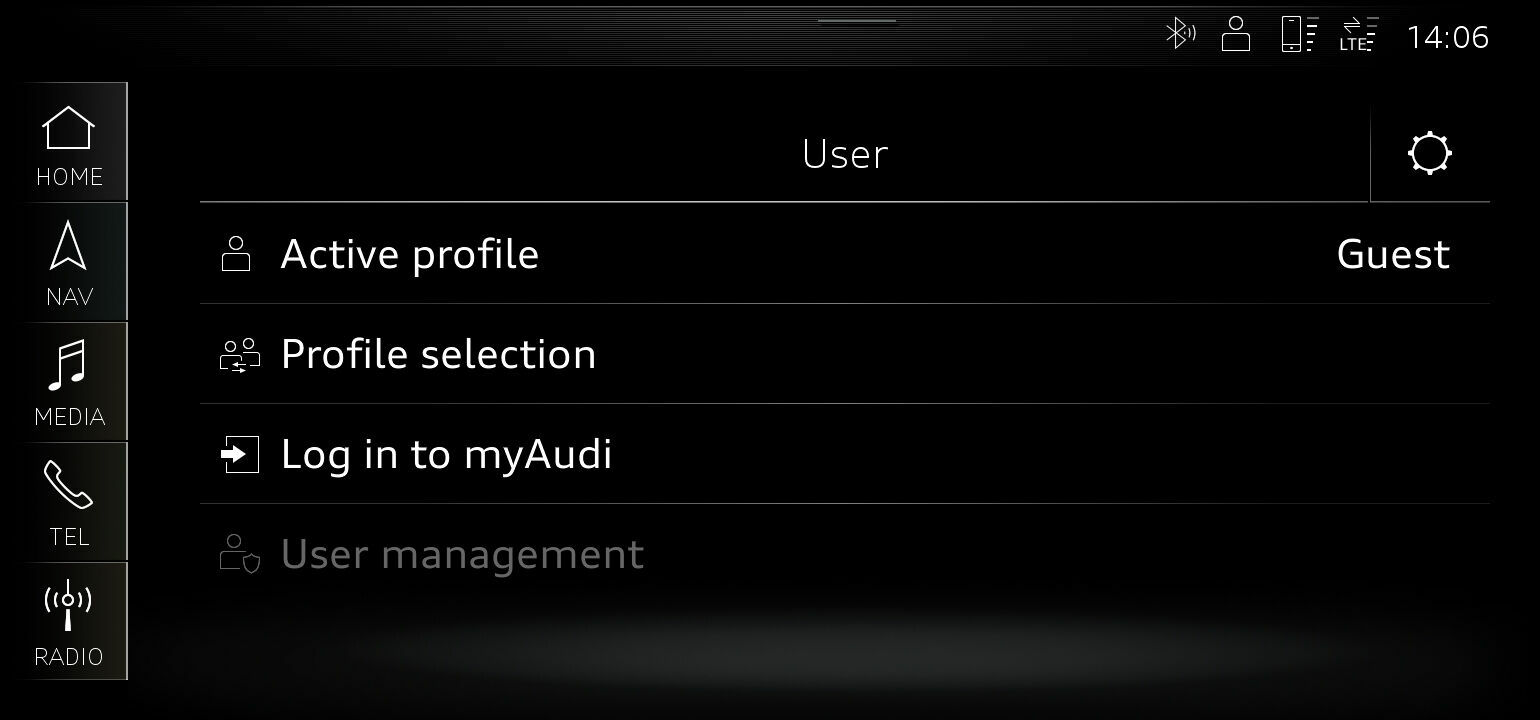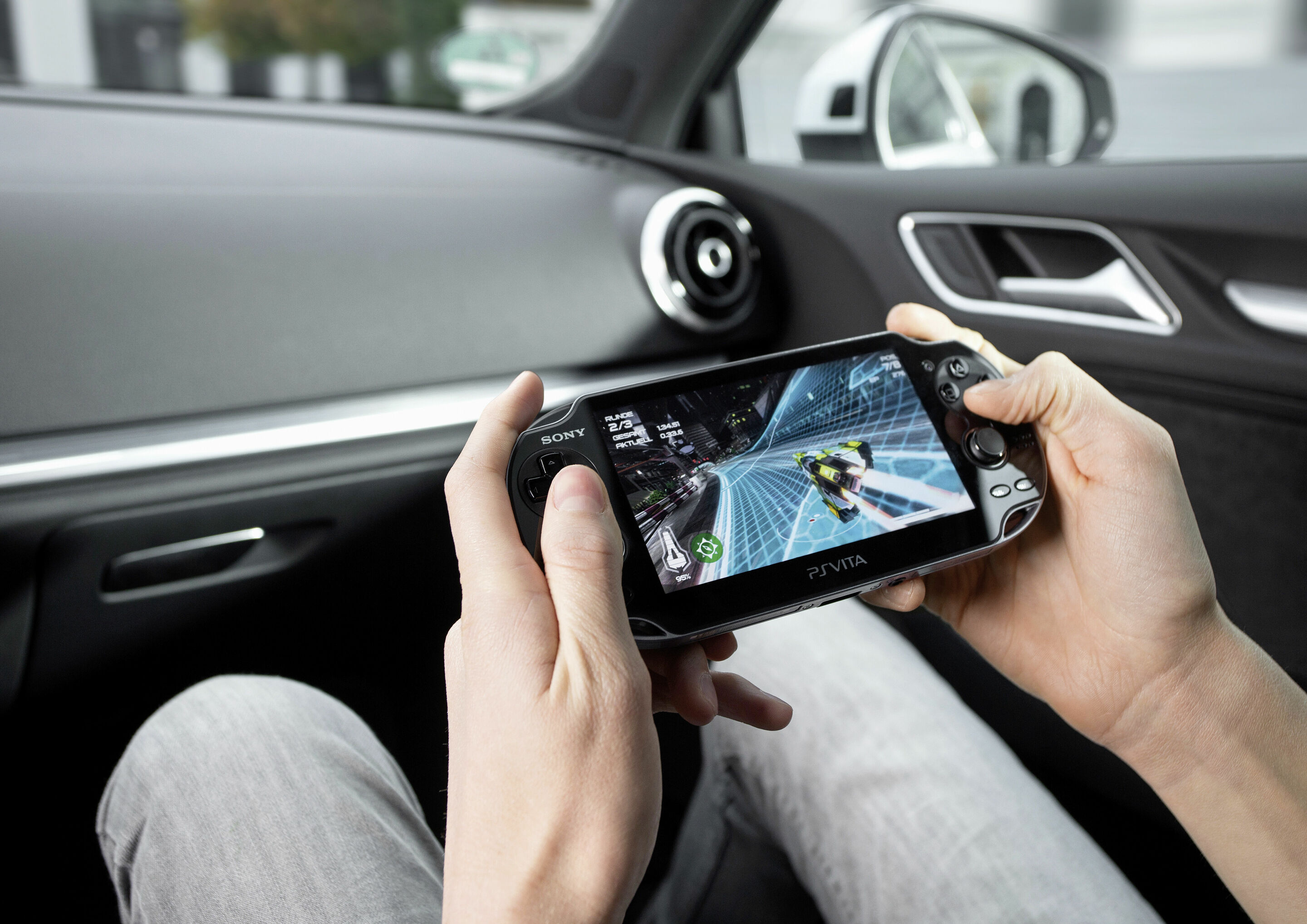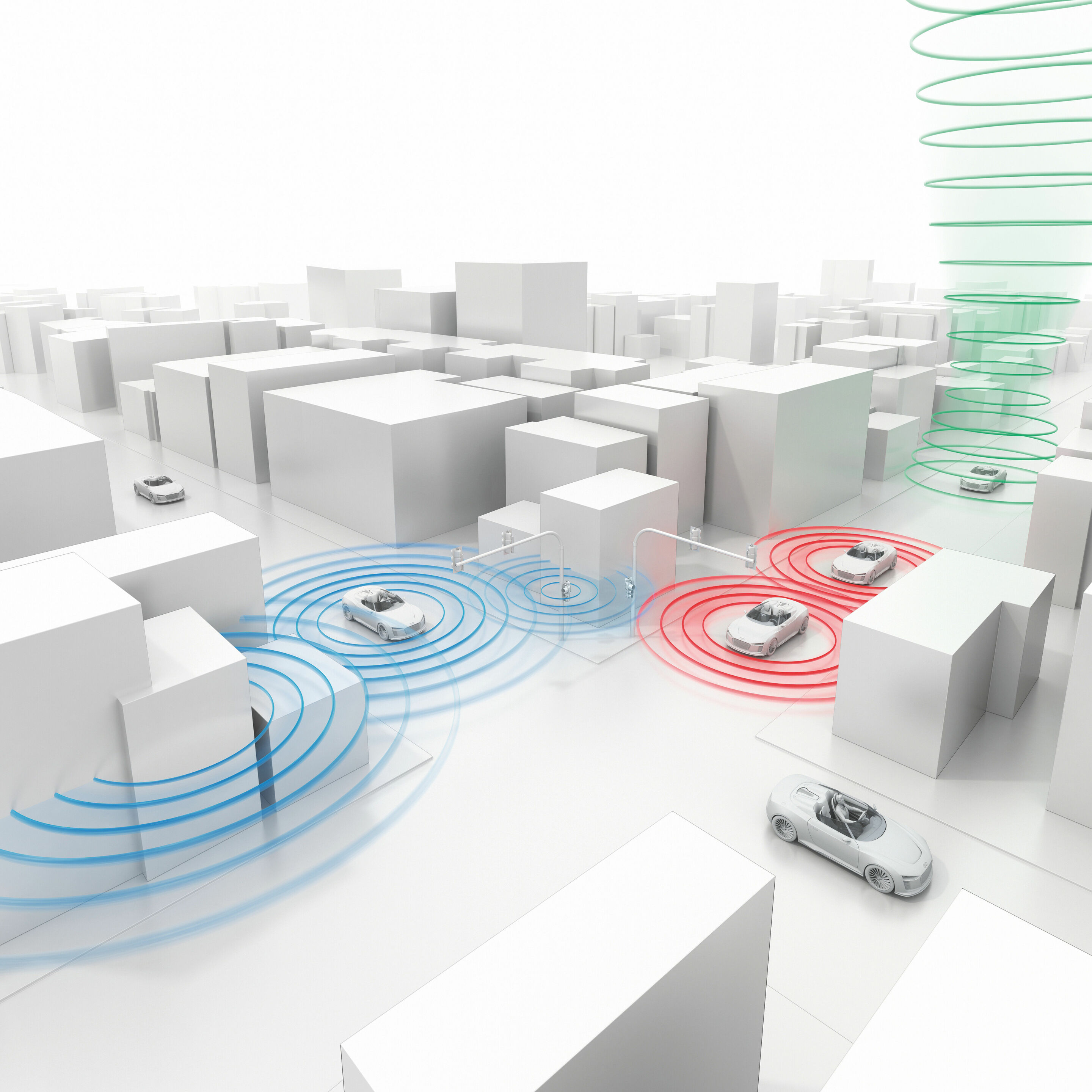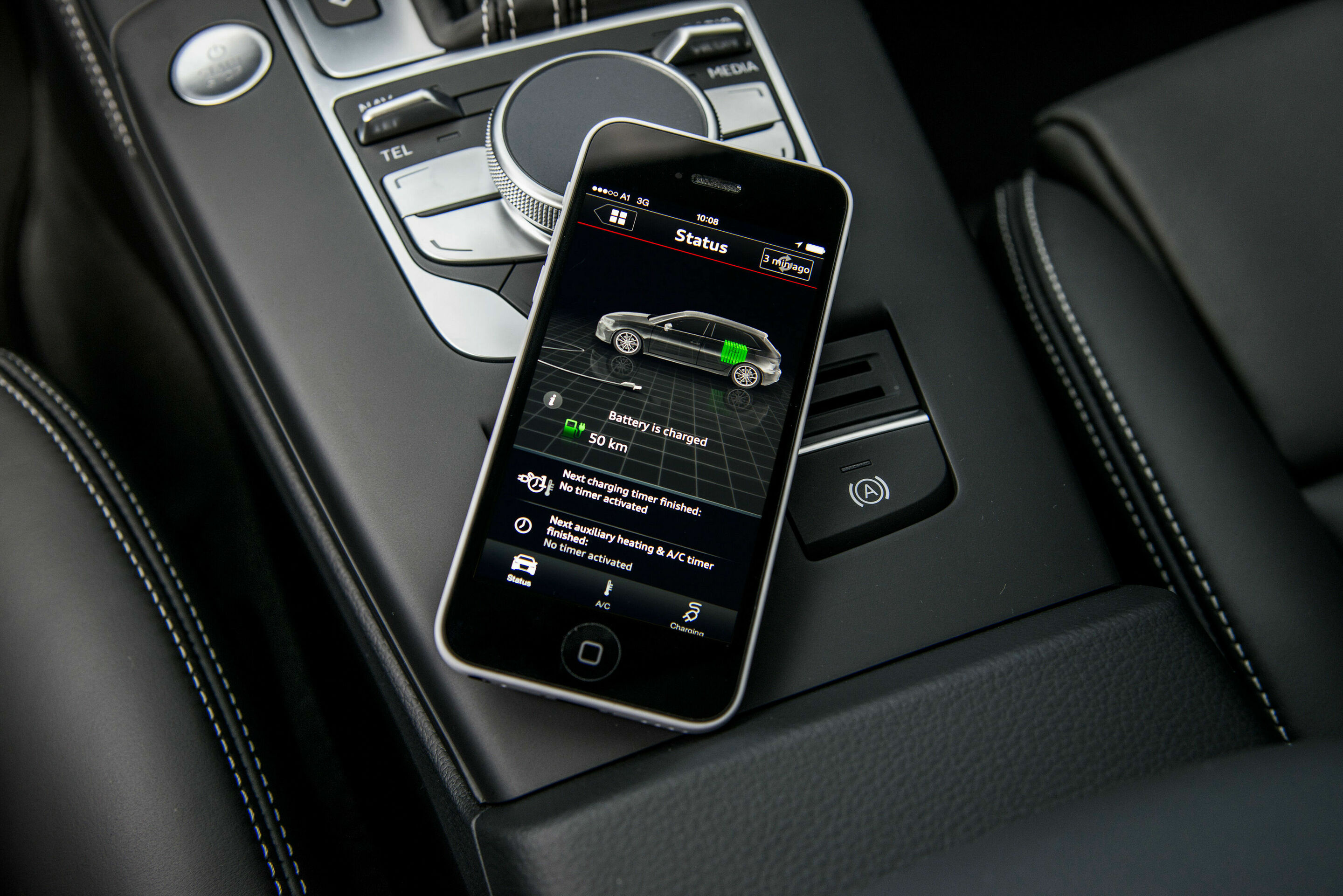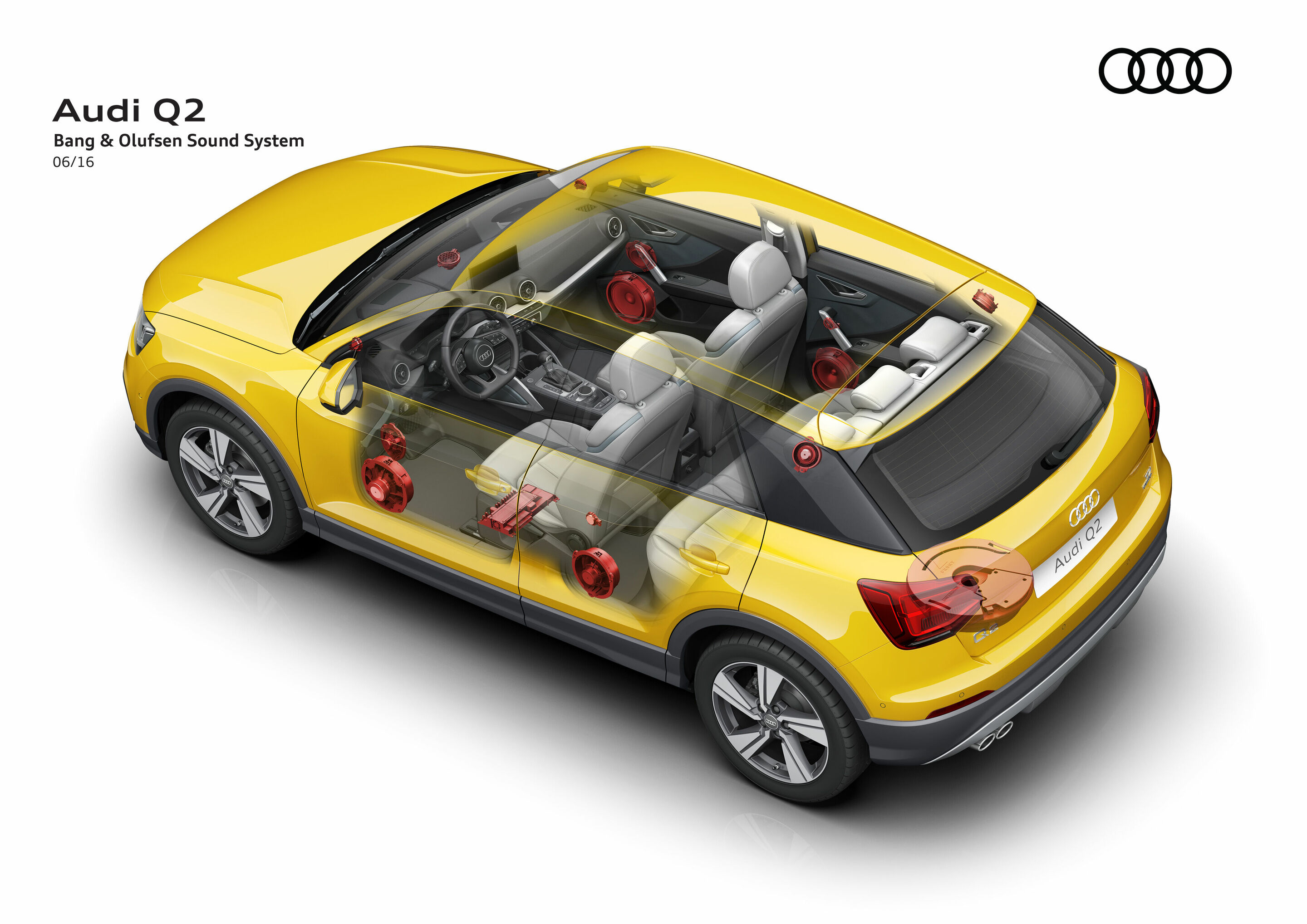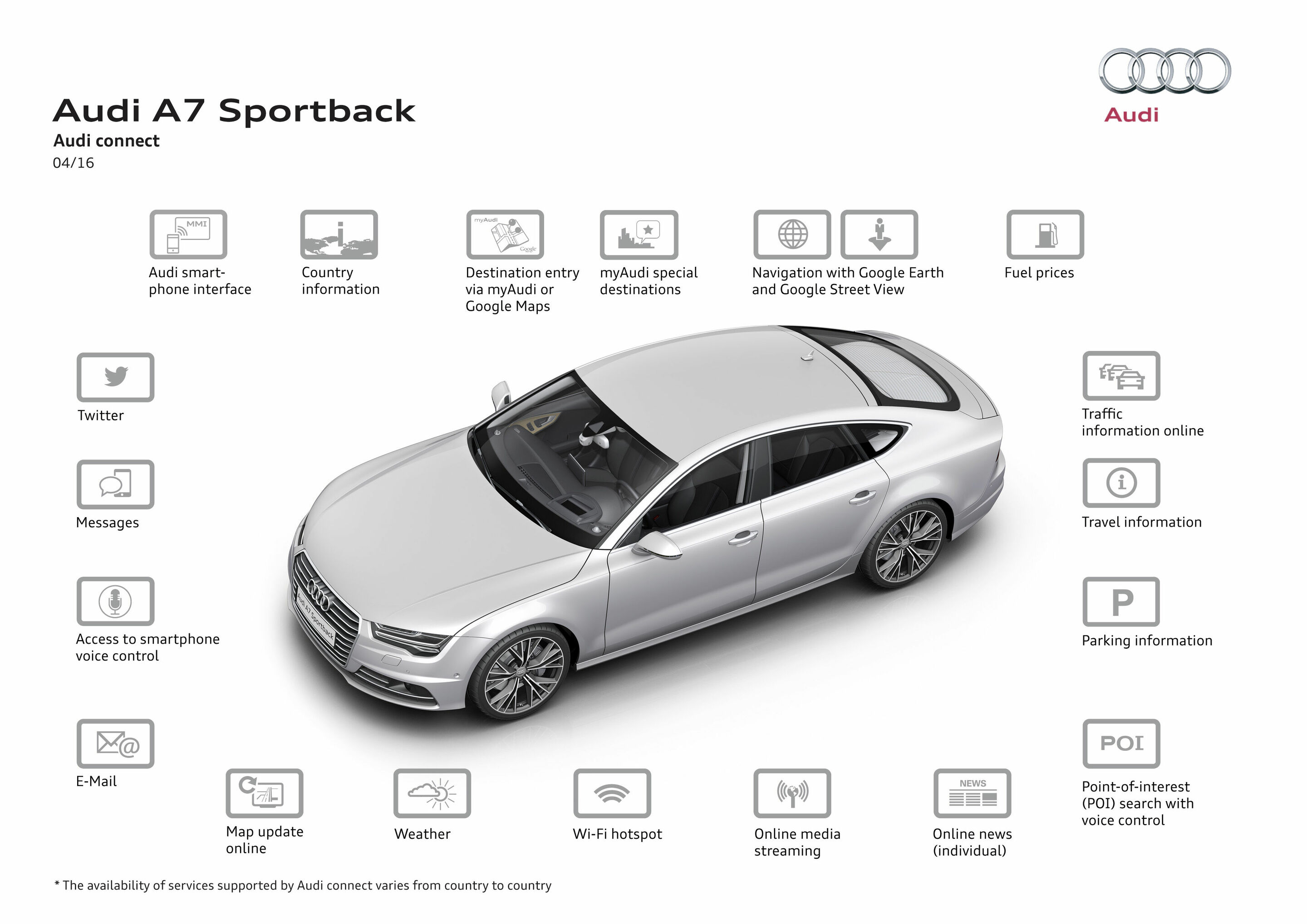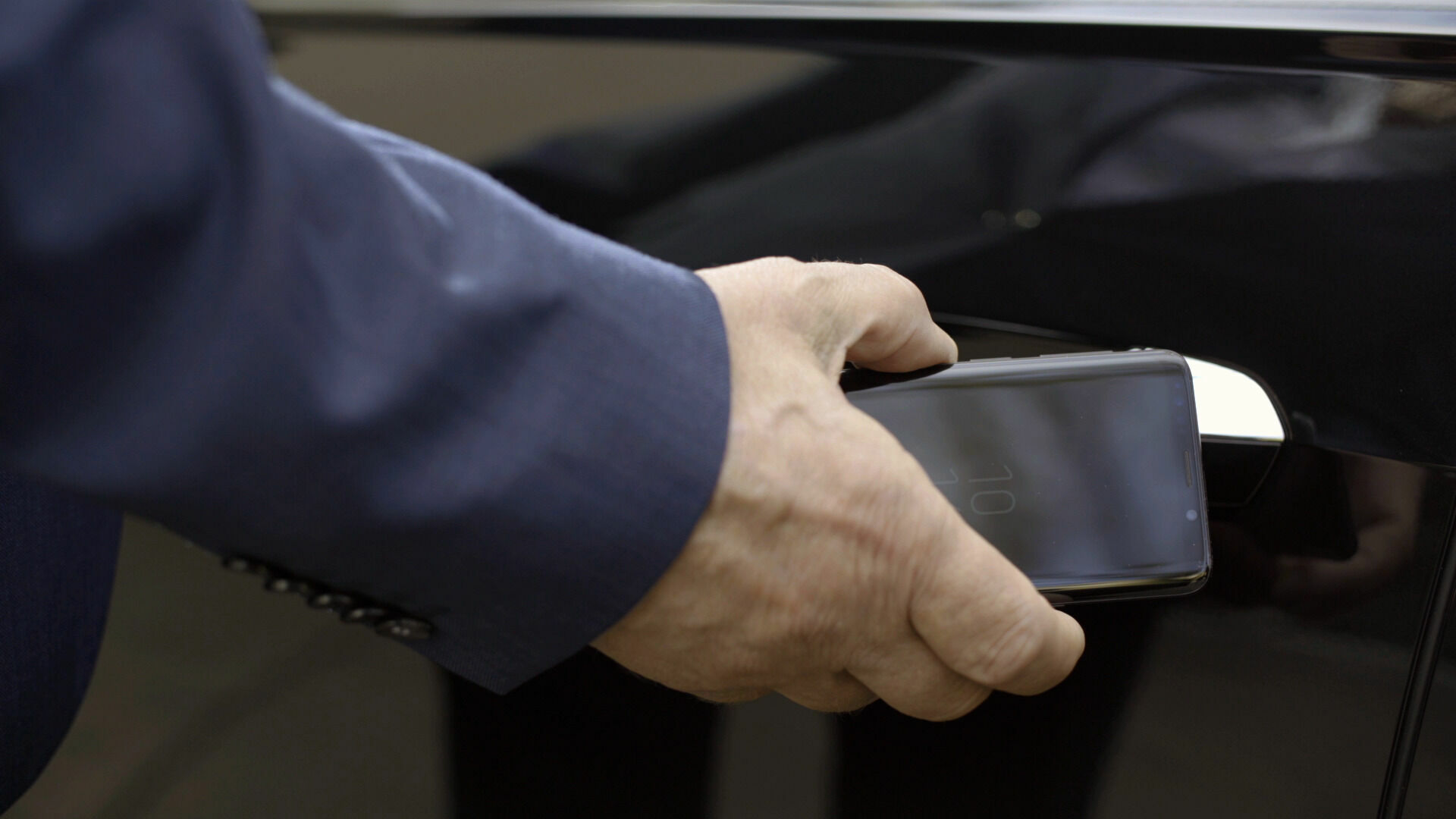Infotainment
Back to overviewIntelligent connectivity and communication solutions are keys to the future of the automobile. With its LTE module, Audi is connecting its models to the World Wide Web and is integrating smartphones into the vehicle infotainment system in a variety of ways.
Audi connect
Audi connect delivers the brand’s internet services to the car. Depending on the model, the broad spectrum of features ranges from navigation with Google Earth and Google Street View to traffic information online and parking place search and finally the services of Audi connect safety & service. In the line-up for some models are also Car-to-X services, which make use of the swarm intelligence of the Audi fleet.
The Audi connect services are displayed on the screen in the car (in the MMI or the Audi virtual cockpit), and they are operated from the multifunction rotary/push-button control, by MMI touch response or by voice command. The driver can also have most information read aloud, such as personalized messages, e-mails, text messages and information from social network portals such as Twitter.
Audi connect safety & service
The services of Audi connect safety & service are organized into two parts. The first cluster comprises emergency call, online roadside assistance and Audi service request. In the event of a serious accident, such as one that has activated the airbag, the car independently initiates an emergency call. It establishes a voice and data connection with the Emergency Call Center and supplies important data such as GPS coordinates, direction of travel and number of occupants. A specially trained service employee will ask for additional details regarding the severity of the accident so that optimal assistance measures can be initiated without delay. If the accident victims are not responsive, an ambulance will be dispatched to the scene of the accident. The driver or front passenger can also activate the emergency call manually using a switch in the roof module. Because the emergency call module has its own power source, it can establish a voice connection even if the car’s electrical system has failed. The driver or front passenger can also trigger online roadside assistance manually by pushing a button in the roof module. This connects them to the Audi Service Center, and the location and relevant car status data are transmitted. The vehicle’s Audi service request function sends service-relevant data to the workshop specified by the customer in the myAudi portal two weeks prior to scheduled maintenance. The service partner can then contact the customer to schedule an appointment.
The second part of the packages comprises the remote services, which can be controlled via an app. Examples are locking and unlocking the car, checking where the car is parked and calling up the vehicle status. The status report includes information about the opened/closed state of windows and unlocked/locked state of doors, remaining range, fuel level and oil level, which the customer can have displayed on his smartphone. The app can also be used to conveniently program the optional auxiliary heating function. With Audi e-tron models, owners can call up the charge status and electric range in the myAudi app. They can also activate the charging process and climate control remotely – including at specific times with user-configured timers. Charge and trip statistics round out the offer.
Audi connect key
Audi has digitalized the conventional vehicle key and transferred it to the user’s smartphone in the form of the Audi connect key. It is used to unlock and lock the car, and authorizes engine start-up. Communication between the vehicle and the smartphone is by near field communication (NFC). This technology refers to a standard in which data is transmitted over short distances by radio signal. To unlock the car, the driver holds the smartphone near the handle of the driver’s door which contains an NFC antenna. To start the engine, the phone is placed in the Audi phone box, which is also equipped with an NFC antenna.
The highly sensitive data of the digital key in the smartphone must be protected against read-out, duplication and manipulation. To do this, the Audi connect key is saved in a secure memory and execution environment within the smartphone, either on the SIM card or directly in the device. This secure element is connected directly to the NFC antenna via the single wire protocol (SWP) – which is another security advantage, because the smartphone’s operating system is not involved in the communication between the car and the smartphone.
In the future, customers will be able to share up to 15 keys over-the-air, e.g. with family members, friends or colleagues. The car recognizes the key owner when it is unlocked, and it loads a wide variety of settings from the user’s individual profile – ranging from seat position to air conditioning and navigation settings. This solution makes the one-to-one relationship between a vehicle key and a vehicle obsolete, because one smartphone can store keys for multiple vehicles. For situations in which the driver needs to share the Audi connect key for a short period of time, but the driver does not want to hand over the smartphone, an Audi connect key card in credit card format is available in the car. The driver can activate it and give it to valet parking personnel, for instance, or passed on in the case of a breakdown.
The Audi connect key is always ready for use, even if the smartphone’s battery is not charged (depends on specific model), because the NFC chip draws the energy it needs from an electromagnetic field produced by its counterpart.
Audi connect SIM
The Audi connect SIM is a permanently installed SIM card which customers in Europe can receive, depending on the model and country, in conjunction with the optional Audi connect package. It includes unlimited data for the use of connect services. The Audi connect SIM can also automatically access the provider for a specific country in most European countries, as necessary. This eliminates high, country-specific roaming charges and inconvenient roaming confirmations for the customer.
The customer can also purchase additional data packages for the WiFi hotspot via a special web portal, independently of the integrated Audi connect services. This allows the passengers to surf the internet with up to eight mobile devices.
Audi MMI connect App
The Audi MMI connect app offers many other functions via Audi connect services, which can be operated from the on-board MMI system. They include transferring a smartphone calendar to the screen in the car. The driver can import an appointment location from the smartphone for use as a navigation destination and can transfer the phone number of a contact person as a contact entry. The system reads out the place, time and purpose of an appointment. Moreover, users can use the app to receive over 3,000 internet radio stations and store their favorites on their smartphones. It is also possible to play back music in the car that is stored locally on a smartphone and to use online media streaming with access to Napster products and services. In addition, the Audi MMI connect app can show current traffic information. The “Travel” service recommends travel destinations. Navigation destinations can be planned on a PC or with a smartphone; individual destinations can be sent to the Audi back-end via the myAudi online portal, Google Maps and the Audi MMI connect app. Afterwards, the driver can call up the saved destinations for navigation in the car.
Customers can download the Audi MMI connect app free-of-charge at the Google Play Store or in the App Store. Registration at myAudi is then required. At myAudi, the driver can manage individual connect services, schedule service appointments or obtain information on the car. This requires that the relevant vehicle identification number be stored in the system.
Audi phone box
The Audi phone box with wireless charging connects cell phones to the car antenna wirelessly by near-field coupling. This allows it to deliver appreciably better reception quality. The box also enables inductive charging based on the Qi standard, provided that the mobile device supports it. The current flows from a coil in the base of the box to the receiver coil in the smartphone.
In the Audi A8 (2017), the Audi phone box is available in several versions – for the driver and the rear passengers, and with or without an NFC antenna connection. Depending on other feature selections, it assumes new tasks such as identifying and authorizing the Audi connect key or the Audi connect key card. Rear passengers can use the Audi phone box for discrete phone calls – the rear seat remote control unit serves as the handset in this case.
Audi smartphone interface
The Audi smartphone interface brings Apple Car Play and Android Auto and thus the familiar smartphone environment into the vehicle. Content such as navigation, phone, music and select third-party apps appear in a separate MMI menu or the Audi virtual cockpit (in the Audi TT and Audi R8). Customers can use the car operating system to conveniently access the contents of an iOS or Android device (iOS 7.1 and above, Android at least 5.0 Lollipop) that is connected via the USB port. The Audi smartphone interface acts independently of the navigation system and Audi connect services.
Audi tablet
The Audi tablet has a high-resolution 10.1-inch screen (1,920 x 1,200 pixels) and serves as a flexible Rear Seat Entertainment system. The tablet, which can be ordered in some large models, connects to MMI navigation plus via Wi-Fi. This gives it access to the menus for Radio, Media, Navigation and Car functions. The data transfer runs in both directions – rear passengers can send a planned route to the driver, for instance or, conversely, the driver could start a radio or media program for them from MMI navigation plus.
The Audi tablet, which uses the Android operating system, supports NFC technology (NFC = near field communication) for transmitting data from other Android devices when they are in close proximity. It has 32 gigabytes of internal memory; a microSD card can be used for additional memory.
Clicking the ‘more’ button in the start menu provides access to the internet – to approximately one million apps and games, movies and music, audiobooks, eBooks and office applications. The integrated full HD camera can be used to place a video call via Skype. After the trip, the user can remove the Audi tablet from the car and continue to use it via an external Wi-Fi network.
The Audi tablet reveals its high-quality character in its chassis that is milled from solid anodized aluminum. Together with its battery, it has been thoroughly designed for use in the car. It can also handle high or very low temperatures without problems; the tilt-adjustable bracket on the back of the front seat is collision-proof and removable if required.
In the Audi A8 (2017), the tablets – which are only ordered in pairs – are not only connected to MMI navigation plus, but also to the Rear Seat Remote control panel. This enables a passenger to operate the tablet very comfortably from a leaned back position while it is snapped into its bracket.
Bang & Olufsen Sound System with 3D sound
The Bang & Olufsen Sound System with 3D sound offers a fascinating feature for hi-fi fans – sound that includes the spatial dimension of height. It accomplishes this via several additional loudspeakers. The interior is transformed into a broad sound stage where the music unfolds exactly as it was recorded in the concert hall – without any artificial effects. Behind this technology is an algorithm that Audi developed in collaboration with the Fraunhofer Institute in Erlangen. It takes stereo or 5.1 recordings, computes the information for the third dimension and conditions it for the 3D loudspeakers.
In its top version the Bang & Olufsen Sound System implements 3D sound in the rear seating area too. Using the MMI system and a separate control unit for the rear passengers, depending on the model, the sound setting can be optimized to personal preferences – with a focus on either the front or rear seats, or on all seats.
The centerpiece of the Bang & Olufsen Advanced Sound system in the Audi A8 (2017) is a 1,920 watt amplifier, which operates very efficiently thanks to its ‘Icepower Technology’. The system’s digital signal processor and 24 channels drive 23 loudspeakers with neodymium magnets, which are extremely lightweight and therefore offer minimal distortion. Aluminum loudspeaker grilles with LED light strips accentuate the woofers in the doors. Two tweeters extend from the instrument panel when the system is turned on – both are classic high-end features by Audi and Bang & Olufsen.
Car-to-X
The Car-to-X services utilize the swarm intelligence of the Audi fleet, in which more than one hundred thousand cars are already gathering information globally. They route the data via the mobile radio network to a server that processes the data and makes it available to individual members of the fleet. Along with online traffic sign information, hazard alert and on-street parking, the package also includes the traffic light information service.
In the case of road sign information, the on-board camera analyzes speed limits. The information is fed into updates to the navigation map. Systems like the efficiency assistant utilize this information for predictive and efficient control of driving speed. With the hazard information service, cars warn one another about accidents, broken-down vehicles, slippery road surfaces or impaired visibility. Multiple parameters are evaluated for this purpose, such as the actions of Electronic Stabilization Control (ESC), data from rain and light sensors, headlights and windshield wipers, emergency service calls and cases of airbag triggering. The on-street parking service provides detailed parking information. Vehicles equipped with Car-to-X technology will report to the server in the cloud information on when they enter and exit parking spaces and information about available parking spaces detected by their on-board sensors. This information from the swarm will simplify the search for an available parking space considerably.
Some US cities are already operating a Car-to-X service that will also be gradually rolled out in selected European cities from mid-2019: traffic light information. The car receives the data from the traffic control computer that controls a city’s traffic light systems, allowing the driver to choose their speed to match the next green light phase. If the next traffic light the driver arrives at is red, a countdown in the instrument cluster counts the seconds until the next green light phase; this lets the driver know that they can take their foot off the accelerator pedal sooner. If the driver is already waiting at a red light, they can see the remaining time until the next green light phase in the instrument cluster. The system thus contributes to a predictive and efficient driving style and facilitates a steady flow of traffic.

e-tron route planner
The e-tron route planner supplements navigation. The customer can use it either in the in-car MMI system or in the myAudi smartphone app. In both cases they are shown the optimal route with the required charging points. Besides the traffic situation, the computation also considers the battery’s charge level. The projected arrival time includes any required charging time. The e-tron route planner includes DC charging stations along with most AC charging stations throughout Europe. Route planning includes charging station information such as output and – provided the chargers are so configured – even whether they are currently occupied or out of service.
Detailed information about the remaining range appears on the in-car displays during the trip. Charging planning is continuously updated to the prevailing conditions. For example, an alternative suggestion is made if a targeted DC quick-charging station can no longer be reached. While actively charging, the battery’s current charge status and the remaining charging time is shown on both the in-car display and in the myAudi app. Customers can also opt to receive push notifications as soon as they can continue their journey.
HERE
AUDI AG, in a consortium with the BMW Group and Daimler AG, purchased HERE Technologies, one of the leading software companies for digital navigation maps and location-based services, from the Nokia Corporation at the end of 2015. As a globally leading developer and provider in this field, HERE produces high-resolution, digital navigation maps and offers region-specific services. The central project is HERE HD Live Map. This provides the digital basis for future piloted driving. The new data platform depicts the traffic space as a three-dimensional model that exhibits a new type of precision – precise to the centimeter instead of the meter and dynamic instead of static.
The HERE HD Live Map has three layers: The first, the HD Map, contains a digital image of the surroundings. Guardrails, traffic signs, curbs and similar fixed objects are the reference points to which the self-driving cars of the future can orient themselves precisely. In addition, there is a database with information on hotels, shops and restaurants.
The second layer of HERE HD Live Map is Live Roads – a dynamic layer that provides nearly real-time information on such factors as construction zones, accidents, emergency vehicle operations and black ice. Live Roads content comes primarily from the sensors of participating cars. The intelligent swarm constantly generates comprehensive and always current information about traffic events such as green waves in city traffic, changing speed limits and available parking spots.
The third layer has to do with humanized driving. Future piloted cars will learn from the HERE data pool about choices the owner made in a specific situation resembling the current one. This enables them to modify their driving behavior to match the owners’ preferences.
The HERE HD Live Map consists of tiles, each two kilometers by two kilometers in size. This allows the immense volume of data to be broken down into manageable portions. The data is hosted on the HERE backend. Data transfer from and to the cars take place via mobile network. The LTE standard already offers great potential here, but future solutions promise even higher data rates and faster establishment of connections.
For Audi customers, the map makes complex driver assistance functions such as traffic jam assist and the predictive efficiency assistant even more precise and performance-enhanced. HERE is continually extending its IT competency network by adding new partners.
Modular infotainment platform
Since 2012 Audi installed the modular infotainment platform. The latest models use the third generation of this platform, which is known as MIB 2+. It is state-of-the-art in all performance criteria: computing power, RAM, graphics and energy efficiency.
The central computer consists of two units – the base module that integrates multiple radio tuners, the amplifier, interfaces to data buses and the MMX board (MMX = Multi-Media eXtension). Its core component is a K1 processor by Audi venture partner NVIDIA which combines a quad-core main processor with a 192-core graphics processor. It does its job around 50 times faster than the chip in the first generation of the modular infotainment platform, and it controls the MMI displays. The technology is rounded out by components for Bluetooth, Wi-Fi and LTE data transfer standards and for navigation.
The MMX board has been designed to be a modular plug-in module. It enables simple updating of the hardware – so that the system is always up-to-date. Audi can react quickly and flexibly to the rapid succession of new innovations in consumer electronics and to exploit the potential of new generations of chips optimally.
The domain architecture that Audi has implemented in the MIB 2+ is a promising approach for the overall electrical/electronics architecture in the car. Over the mid-term, a few intelligently networked domain computers will replace countless individual control modules to form a central computing unit.
myAudi app
Since the end of 2017, the myAudi app has been available for all new vehicles launched after mid-2014. It integrates the services of Audi connect on the customer’s smartphone and connects the smartphone with the car. The many functions are organized into three areas on the main menu level: Vehicle, Navigation and Menu.
The Audi connect key, that is available for some models, can be found in the Information submenu – a submenu that also leads to Profile Management, Status Report and Notifications. Twitter, Napster and news online make up the Media area. A completely new feature under the Navigation menu – and very useful in unfamiliar cities – is myAudi navigation. For instance, it can guide the customer who is walking from a hotel to the car that is parked several streets away. In the car, the navigation guidance then switches from the smartphone to the on-board monitor. After the customer gets out of the car at a parking garage, smartphone navigation then guides the customer to the final destination.
The vehicle services enable users to make a number of vehicle settings from a smartphone, such as locking the doors or activating auxiliary heating. In the e-tron models, these functions also include the management of charging and air condition. Drivers can also choose the piloted parking: They exit the vehicle at the parking lot or parking garage entrance, and the car drives the final meters by itself – controlled via the smartphone.
Personalization
In many models starting with the Audi A8 (2017), the driver is able to save preferred settings to individual user profiles. Up to 400 parameters can be personalized here. They range from the seat position to the air conditioning settings, frequently selected navigation destinations and often used infotainment media. The views selected for displays and most of the assistance systems are also included.
A maximum of seven profiles can be managed (5 car users, 1 guest). This is very convenient when the car is used by multiple drivers. The personalization system recognizes the individual user based on a signal from the remote control key or the Audi connect key, and it welcomes the user by name in the Audi virtual cockpit and activates his or her profile. Each driver can create several different personal profiles – such as weekday and weekend profiles, or freeway and country road profiles – and can switch between them during the driving trip.
Wi-Fi hotspot
The Wi-Fi hotspot enables passengers to surf the internet with up to eight mobile devices – from laptops to tablets and smartphones. The internet connection is made via the roof antenna. This facilitates maximum connection stability and excellent reception quality. Encryption by the WPA2 standard ensures the necessary security of data transmissions.
If the car has a permanently installed SIM card (Audi connect SIM), customers can purchase a data package in the online shop operated by Audi partner Cubic Telecom, which they can access via their myAudi account or the MMI system in the car. When customers select a European data package, their data transmissions will automatically continue to work – at a fixed price – whenever crossing an international border, i.e. when switching to a different internet provider. As an alternative, customers can continue to use their own SIM card in the car and connect the car’s Wi-Fi to the internet via their own cell phone providers.
